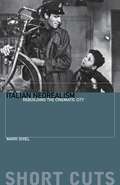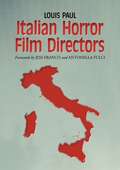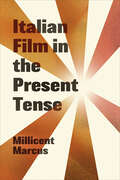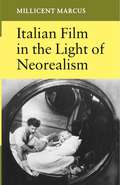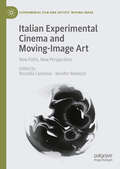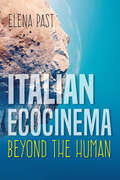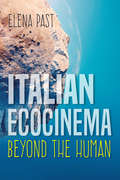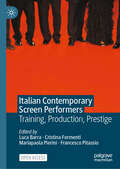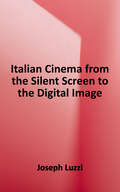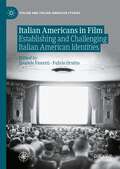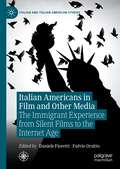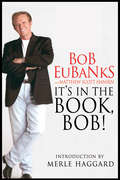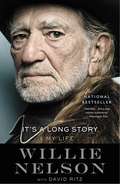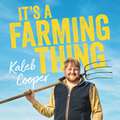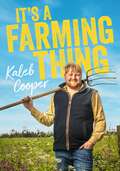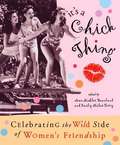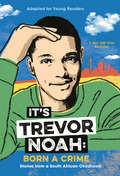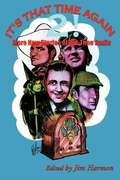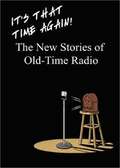- Table View
- List View
Italian Neorealist Cinema
by Christopher WagstaffThe end of the Second World War saw the emergence of neorealist film in Italy. In Italian Neorealist Cinema, Christopher Wagstaff analyses three neorealist films that have had significant influence on filmmakers around the world. Wagstaff treats these films as assemblies of sounds and images rather than as representations of historical reality. If Roberto Rossellini's Roma città aperta and Paisà, and Vittorio De Sica's Ladri di biciclette are still, half a century after they were made, among the most highly valued artefacts in the history of cinema, Wagstaff suggests that this could be due to the aesthetic and rhetorical qualities of their assembled narratives, performances, locations, lighting, sound, mise en scène, and montage.This volume begins by situating neorealist cinema in its historical, industrial, commercial and cultural context, and makes available for the first time a large amount of data on post-war Italian cinema. Wagstaff offers a theoretical discussion of what it means to treat realist films as aesthetic artefacts before moving on to the core of the book, which consists of three studies of the films under discussion. Italian Neorealist Cinema not only offers readers in Film Studies and Italian Studies a radically new perspective on neorealist cinema and the Italian art cinema that followed it, but theorises and applies a method of close analysis of film texts for those interested in aesthetics and rhetoric, as well as cinema in general.
Italian Neorealism: Rebuilding the Cinematic City (Short Cuts)
by Mark ShielItalian Neorealism: Rebuilding the Cinematic City is a valuable introduction to one of the most influential of film movements. Exploring the roots and causes of neorealism, particularly the effects of the Second World War, as well as its politics and style, Mark Shiel examines the portrayal of the city and the legacy left by filmmakers such as Rossellini, De Sica, and Visconti. Films studied include Rome, Open City (1945), Paisan (1946), The Bicycle Thief (1948), and Umberto D. (1952).
Italian Neorealism
by Mark ShielItalian Neorealism: Rebuilding the Cinematic City is a valuable introduction to one of the most influential of film movements. Exploring the roots and causes of neorealism, particularly the effects of the Second World War, as well as its politics and style, Mark Shiel examines the portrayal of the city and the legacy left by filmmakers such as Rossellini, De Sica, and Visconti. Films studied include Rome, Open City (1945), Paisan (1946), The Bicycle Thief (1948), and Umberto D. (1952).
Italian Horror Film Directors
by Louis Paul<p>There is no cinema with such effect as that of the hallucinatory Italian horror film. From Riccardo Freda's I Vampiri in 1956 to Il Cartaio in 2004, this work recounts the origins of the genre, celebrates at length ten of its auteurs, and discusses the noteworthy films of many others associated with the genre. <p>The directors discussed in detail are Dario Argento, Lamberto Bava, Mario Bava, Ruggero Deodato, Lucio Fulci, Umberto Lenzi, Antonio Margheriti, Aristide Massaccesi, Bruno Mattei, and Michele Soavi. Each chapter includes a biography, a detailed career account, discussion of influences both literary and cinematic, commentary on the films, with plots and production details, and an exhaustive filmography. <p>A second section contains short discussions and selected filmographies of other important horror directors. The work concludes with a chapter on the future of Italian horror and an appendix of important horror films by directors other than the 50 profiled. Stills, posters, and behind-the-scenes shots illustrate the book.</p>
Italian Film in the Present Tense (Toronto Italian Studies)
by Millicent MarcusFor observers of the European film scene, Federico Fellini’s death in 1993 came to stand for the demise of Italian cinema as a whole. Exploring an eclectic sampling of works from the new millennium, Italian Film in the Present Tense confronts this narrative of decline with strong evidence to the contrary. Millicent Marcus highlights Italian cinema’s new sources of industrial strength, its re-placement of the Rome-centred studio system with regional film commissions, its contemporary breakthroughs on the aesthetic front, and its vital engagement with the changing economic and socio-political circumstances in twenty-first-century Italian life. Examining works that stand out for their formal brilliance and their moral urgency, the book presents a series of fourteen case studies, featuring analyses of such renowned films as Il Divo, Gomorrah, The Great Beauty, We Have a Pope, The Mafia Only Kills in the Summer, and Fire at Sea, along with lesser-known works deserving of serious critical scrutiny. In doing so, Italian Film in the Present Tense contests the widely held perception of a medium languishing in its "post-Fellini" moment, and instead acknowledges the ethical persistence and forward-looking currents of Italian cinema in the present tense.
Italian Film in the Light of Neorealism
by Millicent MarcusThe movement known as neorealism lasted seven years, generated only twenty-one films, failed at the box office, and fell short of its didactic and aesthetic aspirations. Yet it exerted such a profound influence on Italian cinema that all the best postwar directors had to come to terms with it, whether in seeming imitation (the early Olmi), in commercial exploitation (the middle Comencini) or in ostensible rejection (the recent Tavianis). Despite the reactionary pressures of the marketplace and the highly personalized visions of Fellini, Antonioni. And Visconti, Italian cinema has maintained its moral commitment to use the medium in socially responsible ways--if not to change the world, as the first neorealists hoped, then at least to move filmgoers to face the pressing economic, political, and human problems in their midst. From Rossellini's Open City (1945) to the Taviani brothers' Night of the Shooting Stars (1982). The author does close readings of seventeen films that tell the story of neorealism's evolving influence on Italian postwar cinematic expression.Other films discussed are De Sica's Bicycle Thief and Umberto D. De Santis's Bitter Rice, Comencini's Bread, Love, and Fantasy, Fellini's La strada, Visconti's Senso, Antonioni's Red Desert, Olmi's Il Posto, Germi's Seduced and Abandoned, Pasolini's Teorema, Petri's Investigation of a Citizen above Suspicion, Bertolucci's The Conformist, Rosi's Christ Stopped at Eboli, and Wertmuller's Love and Anarchy, Scola's We All Loved Each Other So Much provides the occasion for the author's own retrospective consideration of how Italian cinema has fulfilled, or disappointed, the promise of neorealism.
Italian Experimental Cinema and Moving-Image Art: New Paths, New Perspectives (Experimental Film and Artists’ Moving Image)
by Rossella Catanese Jennifer MalvezziThis volume presents one of the first systematic inquiries into Italian experimental and avant-garde cinema in English language, thanks to contributions which deepen the history of experimental audio-visual works in Italy. Frameworks of film production, distribution and circulation, as well as theoretical discourses and emblematic case studies are investigated by this edited collection, which tries to provide a broad overview of the complex phenomena that occurred in a century of cinema beyond its industry, its market, and its conventions. The aim of this book is not to offer a comprehensive compendium, but to explore new paths in researching Italian experimental moving image, its history, and new theoretical insights into authors and their works. The volume is structured in thematic sections. Each of them includes different contributions according to two different types: plenary essays, which offer in-depth analyses on historical and theoretical features, and monographic essays, which focus on single authors, collectives, or works.
Italian Ecocinema: Beyond the Human (New Directions in National Cinemas)
by Elena PastEcocriticism and film studies unite in this examination of five Italian films and the environmental questions they raise.Entangled in the hybrid fields of ecomedia studies and material ecocriticism, Elena Past examines five Italian films shot on location and ponders the complex relationships that the production crews developed with the filming locations and the nonhuman cast members. She uses these films—Red Desert (1964), The Winds Blows Round (2005), Gomorrah (2008), Le quattro volte (2010), and Return to the Aeolian Islands (2010)—as case studies to explore pressing environmental questions such as cinema’s dependence on hydrocarbons, the toxic waste crisis in the region of Campania, and our reliance on the nonhuman world. Dynamic and unexpected actors emerge as the subjects of each chapter: playful goats, erupting volcanoes, airborne dust particles, fluid petroleum, and even the sound of silence. Based on interviews with crew members and close readings of the films themselves, Italian Ecocinema Beyond the Human theorizes how filmmaking practice—from sound recording to location scouting to managing a production—helps uncover cinema’s ecological footprint and its potential to open new perspectives on the nonhuman world.“[Past] uniquely and innovatively combines film studies and material ecocriticism with a focus on Italy. Such weaving of tales brings the films to life and reads them as ecological documents and Italian stories.” —Heather I. Sullivan, author of The Intercontextuality of Self and Nature in Ludwig Tieck’s Early Works“A timely and incisive study that interrogates a new, though growing, trend in film criticism and makes an important and rich contribution to Italian film studies, Italian cultural studies, and ecocriticism.” —Bernadette Luciano, author (with Susanna Scarparo) of Reframing Italy: New Trends in Italian Women’s Filmmaking“Part memoir, part close analysis of the films themselves, and illustrated with numerous excellent frame grabs, Past’s book casts a dreamlike spell as it contemplates the past, present, and future of the cinema and moves smoothly between environmental issues and aesthetic and practical concerns.” —Choice
Italian Ecocinema: Beyond the Human (New Directions in National Cinemas)
by Elena PastEcocriticism and film studies unite in this examination of five Italian films and the environmental questions they raise.Entangled in the hybrid fields of ecomedia studies and material ecocriticism, Elena Past examines five Italian films shot on location and ponders the complex relationships that the production crews developed with the filming locations and the nonhuman cast members. She uses these films—Red Desert (1964), The Winds Blows Round (2005), Gomorrah (2008), Le quattro volte (2010), and Return to the Aeolian Islands (2010)—as case studies to explore pressing environmental questions such as cinema’s dependence on hydrocarbons, the toxic waste crisis in the region of Campania, and our reliance on the nonhuman world. Dynamic and unexpected actors emerge as the subjects of each chapter: playful goats, erupting volcanoes, airborne dust particles, fluid petroleum, and even the sound of silence. Based on interviews with crew members and close readings of the films themselves, Italian Ecocinema Beyond the Human theorizes how filmmaking practice—from sound recording to location scouting to managing a production—helps uncover cinema’s ecological footprint and its potential to open new perspectives on the nonhuman world.“[Past] uniquely and innovatively combines film studies and material ecocriticism with a focus on Italy. Such weaving of tales brings the films to life and reads them as ecological documents and Italian stories.” —Heather I. Sullivan, author of The Intercontextuality of Self and Nature in Ludwig Tieck’s Early Works“A timely and incisive study that interrogates a new, though growing, trend in film criticism and makes an important and rich contribution to Italian film studies, Italian cultural studies, and ecocriticism.” —Bernadette Luciano, author (with Susanna Scarparo) of Reframing Italy: New Trends in Italian Women’s Filmmaking“Part memoir, part close analysis of the films themselves, and illustrated with numerous excellent frame grabs, Past’s book casts a dreamlike spell as it contemplates the past, present, and future of the cinema and moves smoothly between environmental issues and aesthetic and practical concerns.” —Choice
Italian Ecocinema Beyond the Human (New Directions in National Cinemas)
by Elena PastEntangled in the hybrid fields of ecomedia studies and material ecocriticism, Elena Past examines five Italian films shot on location and ponders the complex relationships that the production crews developed with the filming locations and the nonhuman cast members. She uses these films—Red Desert (1964), The Winds Blows Round (2005), Gomorrah (2008), Le quattro volte (2010), and Return to the Aeolian Islands (2010)—as case studies to explore pressing enviornmental questions such as cinema's dependence on hydrocarbons, the toxic waste crisis in the region of Campania, and our reliance on the nonhuman world. Dynamic and unexpected actors emerge as the subjects of each chapter: playful goats, erupting volcanoes, airborne dust particles, fluid petroleum, and even the sound of silence. Based on interviews with crew members and close readings of the films themselves, Italian Ecocinema Beyond the Human theorizes how filmmaking practice—from sound recording to location scouting to managing a production—helps uncover cinema's ecological footprint and its potential to open new perspectives on the nonhuman world.
Italian Contemporary Screen Performers: Training, Production, Prestige
by Luca Barra Francesco Pitassio Cristina Formenti Mariapaola PieriniBringing together performance studies, celebrity studies, and media production studies, this open access book offers a comprehensive understanding of the multi-layered condition of film and television performers within the contemporary Italian screen media landscape. By focusing on a selection of stars who reached success from 2000 onwards, the collection highlights how the renewal of the Italian media industry in the late 1990s impacted different aspects of Italian screen performers’ professional lives, from training to promotion and validation strategies.
Italian Cinema from the Silent Screen to the Digital Image
by Joseph LuzziIn this comprehensive guide, some of the world's leading scholars consider the issues, films, and filmmakers that have given Italian cinema its enduring appeal. <p><p>Readers will explore the work of such directors as Federico Fellini, Michelangelo Antonioni, and Roberto Rossellini as well as a host of subjects including the Italian silent screen, the political influence of Fascism on the movies, lesser known genres such as the giallo (horror film) and Spaghetti Western, and the role of women in the Italian film industry. <p><p>Italian Cinema from the Silent Screen to the Digital Image explores recent developments in cinema studies such as digital performance, the role of media and the Internet, neuroscience in film criticism, and the increased role that immigrants are playing in the nation's cinema.
Italian Americans in Film: Establishing and Challenging Italian American Identities (Italian and Italian American Studies)
by Daniele Fioretti Fulvio OrsittoThis book examines how Italian Americans have been represented in cinema, from the depiction of Italian migration in New Orleans in the 1890s (Vendetta) to the transition from first- to second-generation immigrants (Ask the Dust), and from the establishment of the stereotype of the Italian American gangster (Little Caesar, Scarface) to its re-definition (Mean Streets), along with a peculiar depiction of Italian American masculinity (Marty, Raging Bull). For many years, Italian migration studies in the United States have commented on the way cinema contributed to the creation of an identifiable Italian American identity. More recently, scholars have recognized the existence of a more nuanced plurality of Italian American identities that reflects social and historical elements, class backgrounds, and the relationship with other ethnic minorities. The second part of the book challenges the most common stereotypes of Italian Americanness: food (Big Night) and Mafia, deconstructing the criminal tropes that have contributed to shaping the perception of Italian-American mafiosi in The Funeral, Goodfellas, Donnie Brasco, and the first two chapters of the Godfather trilogy. At the crossroads of the fields of Italian Culture, Italian American Culture, Film Studies, and Migration Studies, Italian Americans in Film is written not only for undergraduate and graduate students but also for scholars who teach courses on Italian American Cinema and Visual Culture.
Italian Americans in Film and Other Media: The Immigrant Experience from Silent Films to the Internet Age (Italian and Italian American Studies)
by Daniele Fioretti Fulvio OrsittoItalian Americans in Film and Other Media examines the representation of the Italian immigrant experience from D.W. Griffith’s Biograph Italian Dramas (1908-1913) to the present day. Building on the editors’ previous volume Italian Americans in Film, this collection broadens their scope to address marginalized aspects of Italian Americanness, including the work of women directors and depictions of same-sex relationships. The book consists of three parts. Part I, “The Immigrant Experience”, focuses on feature films and is divided into two sections: “Silent Films” (which analyses some of Griffith’s early films and Barker’s The Italian, 1915), and “Revising Gender Perspectives”, which includes chapters focusing on single films – such as Dmytryk’s Christ in Concrete (1949), De Michiel’s Tarantella (1995), and Bonifacio’s Amexicano (2007) – and survey essays that discuss the Italian American ‘celluloid closet’ and some of Savoca’s films. Part II, “Italian Americans in Other Media”, offers a wide range of essays informed by different approaches that investigate the immigrant experience in terms of transmediality and transnationality. The types of media examined in this section include television and graphic novels as well as puppetry, Instagram, and Internet memes. Part III contains interviews with Italian American scholars, movie directors, and performers. Together, the contributions to this collection demonstrate the vitality, mutation, and persistence of Italian Americanness in visual media.
It's... The Little Guide to Monty Python: ... And Now For Something Completely Different (The\little Book Of... Ser.)
by Orange Hippo!Made from the paper of the mightiest tree in a forest and cut to size with a herring, this Little Guide to Monty Python may be only-ever-so slightly bigger than one of Mr Creosote's wafer-sized mints, but it's packed with enough preposterous comedy power to keep Pythonites stuffed with laughter until breakfast.Monty Python, of course, do not require an introduction. Python are the UK's original legends of comedy; as influential as they are innovative, as incomparable as they are intelligent. For sixty years, their unique brand of ensemble silliness has travelled the world as much as Michael Palin's toothbrush, their legacy growing with each generation.This tiny time can barely contain the 185 or so classic quotes, one liners, character flaws and jokes that made the troupe so famous, all revealed in the profoundly preposterous wit, wisdom and words of the Pythons themselves.All together now... "Always look on the bright side of life..."'I always wanted to be an explorer, but it seemed I was doomed to be nothing more than a very silly person.' Michael Palin
It's... The Little Guide to Monty Python: ... And Now For Something Completely Different (The\little Book Of... Ser.)
by Orange Hippo!Made from the paper of the mightiest tree in a forest and cut to size with a herring, this Little Guide to Monty Python may be only-ever-so slightly bigger than one of Mr Creosote's wafer-sized mints, but it's packed with enough preposterous comedy power to keep Pythonites stuffed with laughter until breakfast.Monty Python, of course, do not require an introduction. Python are the UK's original legends of comedy; as influential as they are innovative, as incomparable as they are intelligent. For sixty years, their unique brand of ensemble silliness has travelled the world as much as Michael Palin's toothbrush, their legacy growing with each generation.This tiny time can barely contain the 185 or so classic quotes, one liners, character flaws and jokes that made the troupe so famous, all revealed in the profoundly preposterous wit, wisdom and words of the Pythons themselves.All together now... "Always look on the bright side of life..."'I always wanted to be an explorer, but it seemed I was doomed to be nothing more than a very silly person.' Michael Palin
It's in the Book, Bob!
by Matthew Scott Hansen Bob EubanksMischievous and irreverent, Bob Eubanks entered American homes for five decades as the host of The Newlywed Game. It's in the Book, Bob! reveals untold stories of The Newlywed Game, and much much more. Bob's career ranged from game show host to concert promoter, from rock and roll DJ to manager of many of the leading country singers. In this funny and surprising book, Bob tells his story-and takes you behind the scenes of one of the most unusual careers in the history of show business.
It's a Long Story: My Life
by David Ritz Willie NelsonThe definitive autobiography of Willie Nelson "Unvarnished. Funny. Leaving no stone unturned." . . . So say the publishers about this book I've written. What I say is that this is the story of my life, told as clear as a Texas sky and in the same rhythm that I lived it. It's a story of restlessness and the purity of the moment and living right. Of my childhood in Abbott, Texas, to the Pacific Northwest, from Nashville to Hawaii and all the way back again. Of selling vacuum cleaners and encyclopedias while hosting radio shows and writing song after song, hoping to strike gold. It's a story of true love, wild times, best friends, and barrooms, with a musical sound track ripping right through it. My life gets lived on the road, at home, and on the road again, tried and true, and I've written it all down from my heart to yours. Signed,Willie Nelson
It's a Farming Thing: Life according to Kaleb, the breakout star of Clarkson's Farm
by Kaleb Cooper'A lot of those old sayings, 'Red sky at night...' and so on, are based on real knowledge. Not that red sky at night really does mean shepherd's delight - the only thing that's ever going to delight a shepherd is changing their job and not having to work with sheep any more.'When Kaleb Cooper was in and out of school as a kid, if anyone had told him he would one day be a star of a hit TV show and a Sunday Times bestselling author, he'd have thought the Cotswolds had a crack problem. But Clarkson's Farm catapulted Kaleb into the limelight and into our hearts. Now his new book, It's a Farming Thing, shares the highs, lows and unexpected adventures of life at Diddly Squat Farm, and how Kaleb went from being a thirteen-year-old with a few chickens and a huge work ethic to one of the biggest names in farming today. Whether he's wrestling with temperamental tractors, or dodging the wrath of cantankerous cows, this is Kaleb as you know him and love him, telling us why he thinks farming is the best job in the world.
It's a Farming Thing
by Kaleb Cooper'A lot of those old sayings, 'Red sky at night...' and so on, are based on real knowledge. Not that red sky at night really does mean shepherd's delight - the only thing that's ever going to delight a shepherd is changing their job and not having to work with sheep any more.' Kaleb Cooper - star of hit TV show Clarkson's Farm and Sunday Times bestselling author - has been catapulted into the limelight and his new book, Life According to Kaleb, he shares the highs, lows and unexpected adventures of life at Diddly Squat from wrestling with temperamental tractors to dodging the wrath of cantankerous cows and after all that why he still believes he has the best job in the world. Kaleb reveals his true, loveable, funny and down-to-earth self, with deadpan gags and unique observations that will have you crying with laughter. Utterly hilarious, this is Kaleb as you know and love him, telling the story of how he has become one of the biggest names in farming today.
It's a Farming Thing
by Kaleb Cooper'A lot of those old sayings, 'Red sky at night...' and so on, are based on real knowledge. Not that red sky at night really does mean shepherd's delight - the only thing that's ever going to delight a shepherd is changing their job and not having to work with sheep any more.' Kaleb Cooper - star of hit TV show Clarkson's Farm and Sunday Times bestselling author - has been catapulted into the limelight and his new book, Life According to Kaleb, he shares the highs, lows and unexpected adventures of life at Diddly Squat from wrestling with temperamental tractors to dodging the wrath of cantankerous cows and after all that why he still believes he has the best job in the world. Kaleb reveals his true, loveable, funny and down-to-earth self, with deadpan gags and unique observations that will have you crying with laughter. Utterly hilarious, this is Kaleb as you know and love him, telling the story of how he has become one of the biggest names in farming today.
It's a Chick Thing
by Ame Mahler Beanland Emily Miles TerryA fun collection of spririted stories pays homage to the special and unique times that strenghten the bonds of female friendships.
It's Trevor Noah: Stories from a South African Childhood (Adapted for Young Readers)
by Trevor NoahThe host of The Daily Show, Trevor Noah, tells the story of growing up half black, half white in South Africa under and after apartheid in this young readers' adaptation of his bestselling adult memoir Born a Crime: Stories from a South African Childhood. <p><p>Trevor Noah, the funny guy who hosts The Daily Show, shares his remarkable story of growing up in South Africa, with a black South African mother and a white European father at a time when it was against the law for a mixed-race child like him to exist. <p><p>But he did exist--and from the beginning, the often-misbehaved Trevor used his keen smarts and humor to navigate a harsh life under a racist government. <p><p>This compelling memoir blends drama, comedy, and tragedy to depict the day-to-day trials that turned a boy into a young man. In a country where racism barred blacks from social, educational, and economic opportunity, Trevor surmounted staggering obstacles and created a promising future for himself, thanks to his mom's unwavering love and indomitable will. <p><p>It's Trevor Noah: Born a Crime not only provides a fascinating and honest perspective on South Africa's racial history, but it will also astound and inspire young readers looking to improve their own lives. <P><b>A New York Times Bestseller</b>
It's That Time Again! Volume 2: More New Stories of Old-Time Radio
by Jim HarmonA rousing, mysterious, hilarious collection of the best NEW stories of old-time radio.
It's That Time Again! The New Stories of Old-Time Radio
by Ben OhmartNEW stories of old-time radio, written by today's most knowledgable OTR authors and fans.

